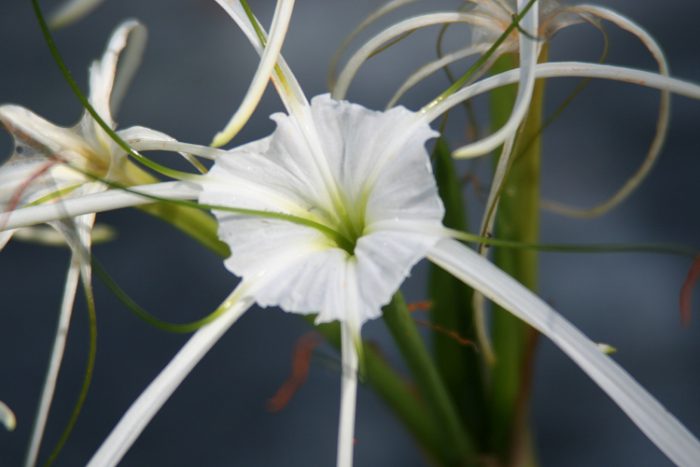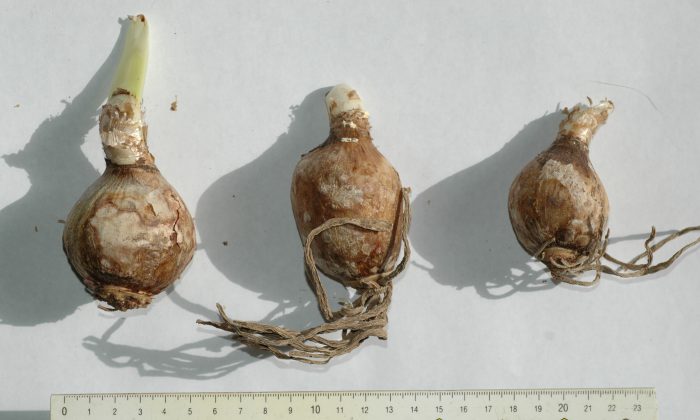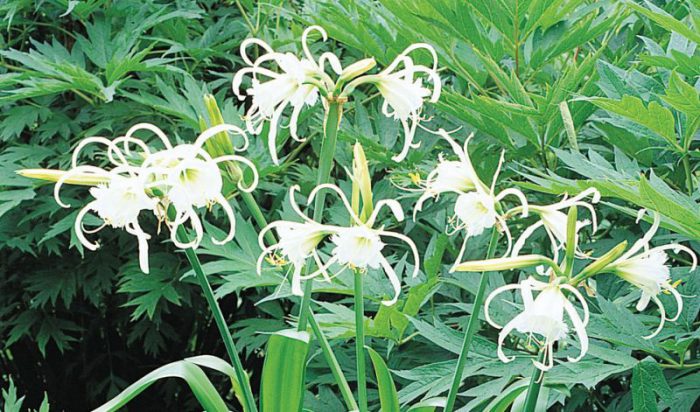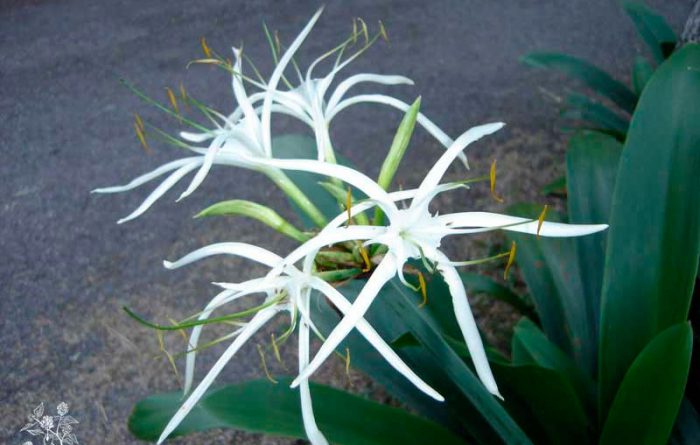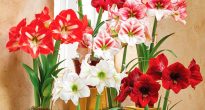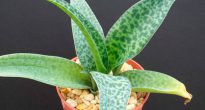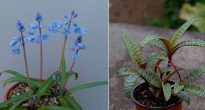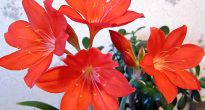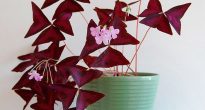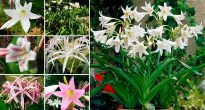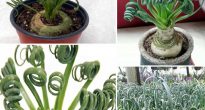Plants of the genus Hymenocallis are directly related to the Amaryllidaceae family. This genus unites more than 50 species of bulbous plants. In nature, they can be found in various regions of South America.
A rather large pear-shaped bulb covered with a layer of dry, shiny scales. A mature onion usually has a diameter of 10 centimeters. Vaginal sessile leaves are arranged strictly alternately and grow in the same plane. In length, such leaves can reach from 0.5-1 meter. Most species have belt-shaped leaves, with the central vein depressed and there is a pointed tip. The leaf is colored deep green and has a glossy surface. Among the many species, there are both evergreens and those that shed all the leaves during a prolonged drought.
These plants stand out among the rest for their extremely unusual flowers. In their shape, they resemble either a spider with long legs or a star. The calyx has 6 narrow-linear sepals, which can be up to 20 centimeters long. They are greenish at the base, and then repeat the color of the petals. There are species in which the sepals are bent back only at the ends, and there are those in which they sag freely from the base. The radially symmetrical, conglomerate corolla consists of 6 petals, which are cut to varying degrees at the ends. The petals are fused with 6 stamens and form a funnel-shaped crown, reaching a depth of 5 centimeters. There are species that have stamens only slightly shorter than sepals. Large oval-shaped anthers are yellowish-orange or deep yellow. Umbellate or corymbose inflorescences consist of 2-16 fragrant flowers, and they also have 2 or 3 bracts. The peduncle, bare with a slightly flattened section, is almost as long as the leaves. When the plant has faded, it produces oval-shaped green fleshy fruits with large seeds inside.
Hymenokallis care at home
It is quite easy to care for such a plant.The most important thing in caring for it is timely watering and proper lighting.
Illumination
Among the numerous representatives of the amaryliss family, this plant loves light most of all. It calmly transfers the direct rays of the sun and needs bright lighting. It is recommended to place such a flower on windows with a south, south-west and south-east orientation. Hymenokallis will not bloom on the window in the northern part of the room.
In summer, it is recommended to take it out into the fresh air (in the garden, on the balcony)
For species that bloom in winter, it is necessary to provide good supplementary lighting and ten hour daylight hours.
Temperature regime
The plant grows and develops well in spring and summer at moderate temperatures that correspond to mid-latitudes. If there is no additional lighting in winter, then evergreen species need to lower the temperature somewhat. To do this, the pot should be as close to the glass as possible, and the window should be closed with a film or you can use a transparent box. This will separate the plant from the warm air. The optimum temperature for this period is 14-18 degrees. If there is artificial lighting, then there is no need to lower the temperature.
Bulbs of deciduous species extracted from the ground must be placed in a cool (from 10 to 12 degrees) and very dry (it is necessary that the scales rustle like onion husks).
How to water
The greatest difficulty in caring for hymenokallis is watering. It can be very difficult to find the optimal watering regime. Since this flower in nature prefers to grow in coastal areas and wetlands, during intensive growth and flowering it needs to create suitable conditions. The soil should be slightly moistened all the time. But at the same time, make sure that the liquid does not stagnate in the pot, as this can lead to rotting of the bulb.
In winter, you need to water less. You can find out that the flower lacks moisture by looking at the leaves - they lose their turgor and become lethargic. In this case, watering should be increased. Bulbs of deciduous plant species are not watered in winter.
For irrigation, settled water at room temperature is suitable.
Humidity
No artificial increase in air humidity is required. However, for hygienic reasons, a regular warm shower is recommended. In this case, only the foliage should be washed, and the buds and flowers should be protected from water.
Earth mixture
Suitable soil should be loose, slightly acidic (pH 5.0 - 6.0) and rich in nutrients. There are several options for a soil mixture suitable for planting hymenokallis. The most common ones are:
- Leafy and sod land, coarse river sand in a ratio of 3: 1: 1.
- Leafy, soddy and humus soil, coarse river sand and peat in a ratio of 2: 2: 2: 1: 1.
For planting, you can also use a commercial potting soil mixture for bulbs. However, in order to prevent rot, it is recommended to add a small amount of crushed charcoal to it.
This flower requires a large enough pot for planting, because its roots are very powerful and grow quickly. At the bottom of the container, it is imperative to make a good drainage layer of expanded clay. It will help to avoid stagnation of liquid in the substrate. It is necessary to plant the bulb so that its third rises above the surface of the substrate.
Top dressing
Top dressing is carried out during intensive growth, as well as flowering with a frequency of 1 time in 2 or 3 weeks. To do this, use fertilizer for flowering indoor plants or ready-made liquid fertilizer for bulbous plants. You need to use the dosage indicated on the package. However, make sure that there is not a lot of nitrogen in the fertilizer you choose, as it leads to intensive foliage growth, and the quality of flowering deteriorates. Also, this chemical element can cause rotting of a succulent bulb.
During a relative dormant period, fertilizer should not be applied to the soil.
Transplant features
Since the plant reacts extremely negatively to transplantation, this procedure is carried out quite rarely, as a rule, once every 3 or 4 years.
Reproduction methods
Hymenokallis can be propagated by seeds or daughter bulbs. Such bulbs begin to form after the flower is 3 or 4 years old. As a rule, reproduction by children is carried out during transplantation. To do this, you should carefully enough to separate the daughter bulb from the mother, and then plant it in a separate container.
You need to sow seeds as described in the instructions, which should be placed on the package.
Pests and diseases
This spectacular plant can house such harmful insects as aphids, spider mites and thrips... After these pests are found on the foliage, in the near future it is necessary to thoroughly treat the bush with insecticides of the appropriate action (for example, phytoverm or actellik).
The most common diseases are gray rot on the bulbs. For preventive purposes, during planting and transplanting, the bulbs must be carefully examined. After finding a sore spot, it is carefully cut out, while the places of the cuts must be processed with chopped charcoal. But this is only in the case of a small defeat. If the bulb is very badly infected, then it is no longer possible to save it.
Most often, rot develops due to stagnant water in the substrate, especially during a cool winter.
Also, the plant may not bloom - this is due to the fact that it lacks light, with too warm wintering, as well as with poor feeding.
Variety of names
This plant is also popularly called "spider lily", Peruvian lily. It also has other names.
Also, according to some experienced botanists, this plant is also called Ismene, while this name is synonymous with Hymenocallis. However, a larger number of classifiers have the opinion that these are two completely different plant species. At the same time, the genus of change was at one time separated from the genus Hymenokallis. The most striking difference between these flowers is the false stem and the change. It gradually forms as a result of the withering away of foliage. They also differ in the orientation of the pedicel. In change, the flowers are inclined and sometimes lie almost horizontally, while in hymenocallis they are directed upward almost vertically. Hymenokallis also has monochromatic crowns, and the crown has a green longitudinal strip. So, hymenokallis narcissus, according to some characteristics, can be attributed to the genus Ismen, while this species has a second synonymous name - Ismen Narcissus. In such a flower, the pedicels are horizontally bent, while the line of fusion of stamens with petals is painted in a dark green color.
Hymenokallis and pancratium are also often confused. Despite the fact that their flowers are very similar, the plants themselves are related to different genera. They differ greatly in foliage. Hymenokallis have a lot of dark or rich green leaves, they are glossy, “grassy”. In pancratium, there are quite few hard, narrow leaves, they are almost succulent and painted in a grayish-blue color with a bluish tint.
Video review
Main types
Hymenocallis caribbean (Hymenocallis caribaea)
This type is most popular with flower growers. Such an evergreen plant can be found in nature on the coast of the Antilles. He has no rest period. The narrow-lanceolate leaves are dark green in color and reach 90 centimeters long and 5–7 centimeters wide. Blooms in winter for 4 months. At the top of the peduncle is an umbrella-shaped inflorescence, which consists of 3-5 large flowers, painted white. Narrow sepals reach 7 centimeters in length.
Hymenocallis early (Hymenocallis festalis)
Quite often grown indoors.It occurs naturally in Peru, but is often grown as a garden plant in subtropical and tropical areas. This species has rather short (40 to 60 centimeters) glossy, belt-like leaves, painted in dark green. Flowering lasts from mid-spring to mid-summer. Snow-white flowers have a diameter of 10 centimeters. Large, wide-open crown. Curved sepals are folded into neat rings.
Hymenocallis narcissus (Hymenocallis amancaes)
It is an evergreen plant endemic to the coastal mountain regions of Peru. The dark green leaves are xiphoid. The yellow flowers have a large crown and quite wide. It completely absorbs the stamens, and only anthers remain outside. Sepals are only 1.5–2 times longer than the crown. There are varieties with purple or white flowers. This plant blooms from mid-summer to mid-autumn.
Hymenocallis fine (Hymenocallis speciosa)
The homeland of this evergreen plant is the Antilles. Long (up to 60 centimeters) leaves have a lanceolate-elliptical shape. The peduncle protrudes 1/3 above the leaf rosette and bears an umbrella-shaped inflorescence consisting of 5-16 snow-white flowers. Each flower has a diameter of about 15 centimeters, while the arcuate curved sepals can be up to 7 centimeters long.
Hymenocallis cordifolia (Hymenocallis cordifolia)
This species is very different from the rest. Long-petiolized leaves of such a plant have an elongated heart-shaped shape. Snow-white flowers with long narrow drooping sepals practically do not have a crown.
Hymenocallis tubiflora (Hymenocallis tubiflora)
In nature, it can be found in Trinidad and on the northern coast of South America. Its flowers are similar to the hymenokallis cordifolia. However, the petiole leaves are broadly lanceolate.
All species grown indoors have very few varieties. So, most often the flowers are painted white, less often yellow. There are also differences in the size of the crown and in the shape of the sepals. Variegated forms of such flowers are very popular. They have greenish-yellow or white longitudinally spaced stripes along the leaf edge.

